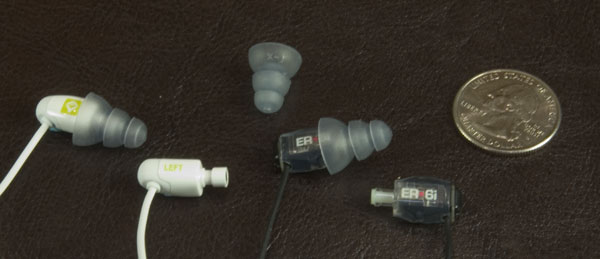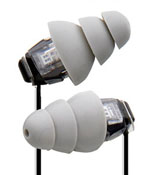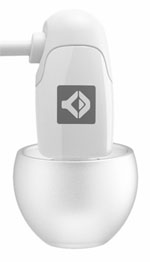| Columns Retired Columns & Blogs |
Great Motorcycling Headphones: Jays q-JAYS and Etymotic ER6i

This story originally appeared at InnerFidelity.com
Whenever I can, I spend time on the back of this beast: a 2005 Yamaha FJR 1300 super sport touring bike. This baby eats continents. I once left Bozeman, Montana in the morning and slept in a cornfield in Iowa that night. I really dig long-distance travel --- the gradual and ever-changing scenery, weather, and geology punctuated with little towns and churches is mesmerizing. Nonetheless, I need my tunes to complete the experience, and it took me a good long while to find just the right headphones to accompany me on my journeys.

The q-JAYs (left) and ER6i (right) with the Etymotic small frosted tips (ER6i-15SM).
The problem with motorcycle cans is actually all in the helmet. A properly fitting helmet is very snug. I had big problems when donning and doffing my skid-lid with other in-ear headphones as the helmet would dislodge the earpieces, or really hurt, as the neck brace interfered with the cans as it passed by my ears. I tried all manner of in-ear headphones until I stumbled upon the Etymotic ER6i ($99 MSRP), and later the better sounding and even smaller Jays q-JAY ($269.99 MSRP). Ahhhhhhh … sweet relief! The latter are the smallest in-ear headphones I’ve ever seen, and with a proper tip, they seal well into the ear canal, all but disappearing into your noggin.
 In some states it’s illegal to ride with headphones in, so I can’t recommend it, but I do heartily recommend ear protection while riding. Wind noise in a helmet can reach very unsafe levels. From this page:
In some states it’s illegal to ride with headphones in, so I can’t recommend it, but I do heartily recommend ear protection while riding. Wind noise in a helmet can reach very unsafe levels. From this page:
“Above about 65 km/h or 40 mph the wind noise generated by the airflow over a motorcycle and rider exceeds the noise from the motorcycle itself. Daily noise exposures of working motorcyclists may regularly exceed 90 dB(A).”
That’s enough for permanent hearing damage after about 8 hours. Motorcycling is an inherently dangerous activity; one of the dangers within your control is the potential for hearing loss. Also, the high level of wind noise on in a helmet can mask traffic noise around you. Putting earplugs in will actually help you be more aware of the sound around you. Lastly, wind noise can be very fatiguing; putting in earplugs can help you remain more alert in the latter stages of a long days ride.
In open country, I’ll ride with music or talk radio, and I find that it keeps me more alert. Because the earphones block out so much noise, I can keep the volume down to reasonable levels and still enjoy the talk and tunes. When I roll into a town, I simply mute the music to improve my situational awareness in traffic.

The dash of my bike includes (L to R): Garmin Zumo 550 GPS; Rolls MX42 passive, four-channel mixer; HeadRoom Portable MicroAmp w/DAC and iRiver iHP-140 on top; Beltronics STi radar detector; and Garmin satillite radio antenna.
The Venerable Etymotic ER6i ($99 MSRP)
 The ER6i has been around for ages … and deservedly so. They are very small and fit deep in the ear providing excellent isolation from outside noise. These little cans come with both flanged tips and foam tips, but I found the small frosted triple-flange tips that you have to buy separately work better for me (ER6i-15SM on this page).
The ER6i has been around for ages … and deservedly so. They are very small and fit deep in the ear providing excellent isolation from outside noise. These little cans come with both flanged tips and foam tips, but I found the small frosted triple-flange tips that you have to buy separately work better for me (ER6i-15SM on this page).
The sound of the ER6i is somewhat bass shy, but otherwise quite good. I’ve found that because wind noise is quite loud, high-quality reproduction is rather elusive on a bike, so I tend to think the lower fidelity of the ER6i is less of a worry in this application.
The Tiny Jays q-JAY ($269.99 MSRP)
 Though quite expensive, these amazingly small headphone work exceedingly well on a bike. Because the body of these cans is so small, they easily fit under the helmet without interfering and causing pressure and discomfort. They come with a wide variety of tip sizes, but again, I find the Etymotic ER6i small frosted tips mentioned above are the superior fit for me on these cans. These are easily the most comfortable headphones I’ve worn on a bike.
Though quite expensive, these amazingly small headphone work exceedingly well on a bike. Because the body of these cans is so small, they easily fit under the helmet without interfering and causing pressure and discomfort. They come with a wide variety of tip sizes, but again, I find the Etymotic ER6i small frosted tips mentioned above are the superior fit for me on these cans. These are easily the most comfortable headphones I’ve worn on a bike.
The sound is much better on the q-JAY than the ER6i, but again, I don’t find this as important on a bike than I would otherwise. While not on the bike, however, you’ll find these cans much more enjoyable. The q-JAY is a two-driver design, and has a well-balanced sound, without harshness. Though the highs can sound a bit “breathy” and slightly lacking in definition, the bass impact is superior to the ER6i, and I find they deliver a very pleasant listening experience.

Changing Filters
In-ear monitors can get clogged with earwax from time to time and both models above come with replaceable filters. If earwax or moisture gets on the filters, sound from that earpiece will become noticeably lower in volume. The ER6i come with a filter replacement tool that you screw into the nozzle to remove the filter. The new filter simply inserts back into the nozzle. The q-JAY has little sticker-like filters that apply to the end of the nozzle. These filters clog very easily and you should order extra filters when purchasing these cans.

Summary
 Using in-ear monitors on a motorcycle can reduce fatigue, lessen the likelyhood of hearing damage, and improve situational awareness when used properly. The ER6i and q-JAY in-ear headphones are the most suitable in-ear headphones for motorcycling because they are very small and easily fit under a helmet comfortably. Though significantly more expensive, the q-JAY delivers about the same price/performance ratio for motorcyclists because of the smaller size providing more comfort, and the better sound quality available when not on the bike. Both models heartily recommended.
Using in-ear monitors on a motorcycle can reduce fatigue, lessen the likelyhood of hearing damage, and improve situational awareness when used properly. The ER6i and q-JAY in-ear headphones are the most suitable in-ear headphones for motorcycling because they are very small and easily fit under a helmet comfortably. Though significantly more expensive, the q-JAY delivers about the same price/performance ratio for motorcyclists because of the smaller size providing more comfort, and the better sound quality available when not on the bike. Both models heartily recommended.
Keep the rubber side down and the shiny side up. Ride safe!
- Log in or register to post comments




































